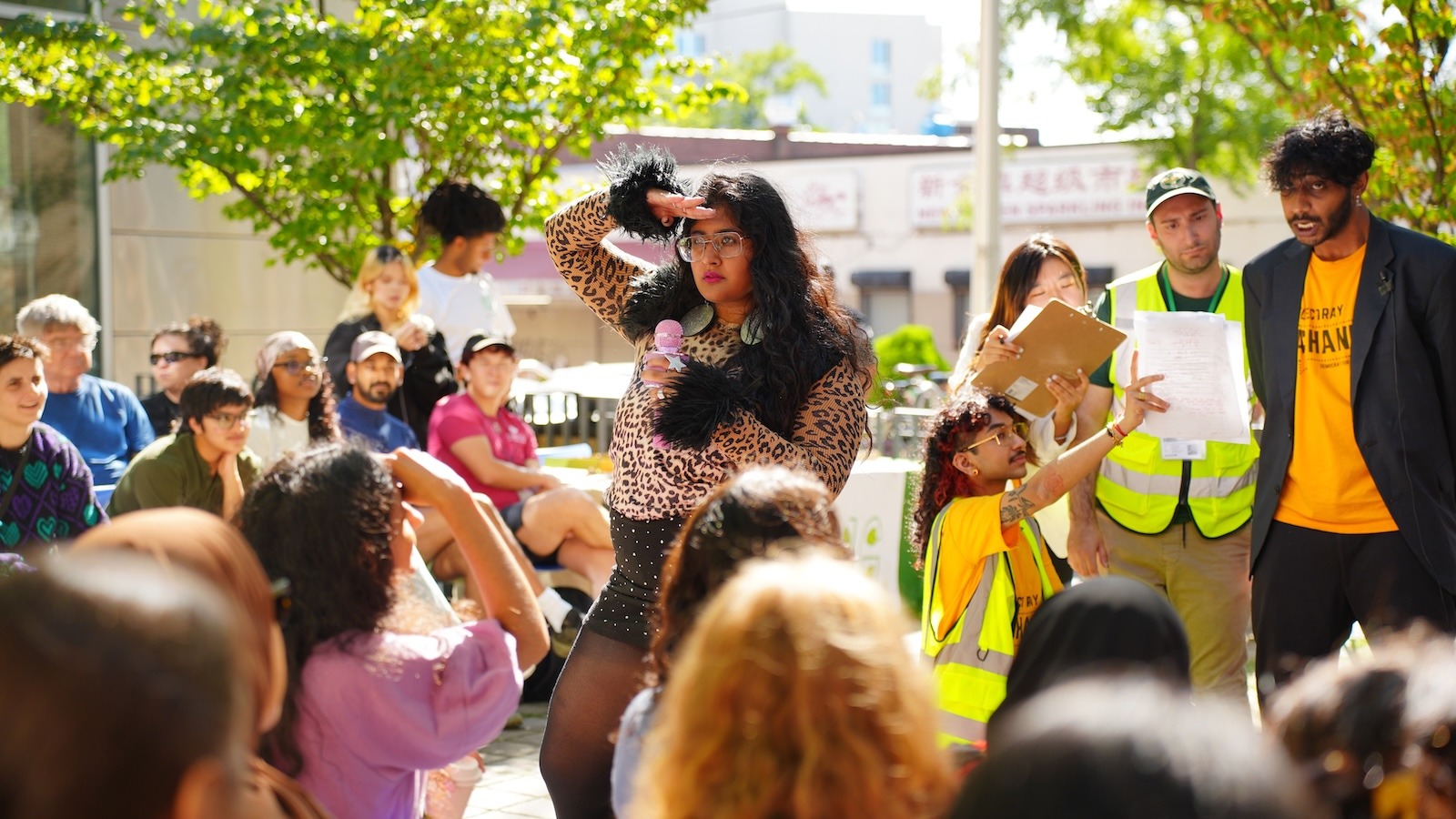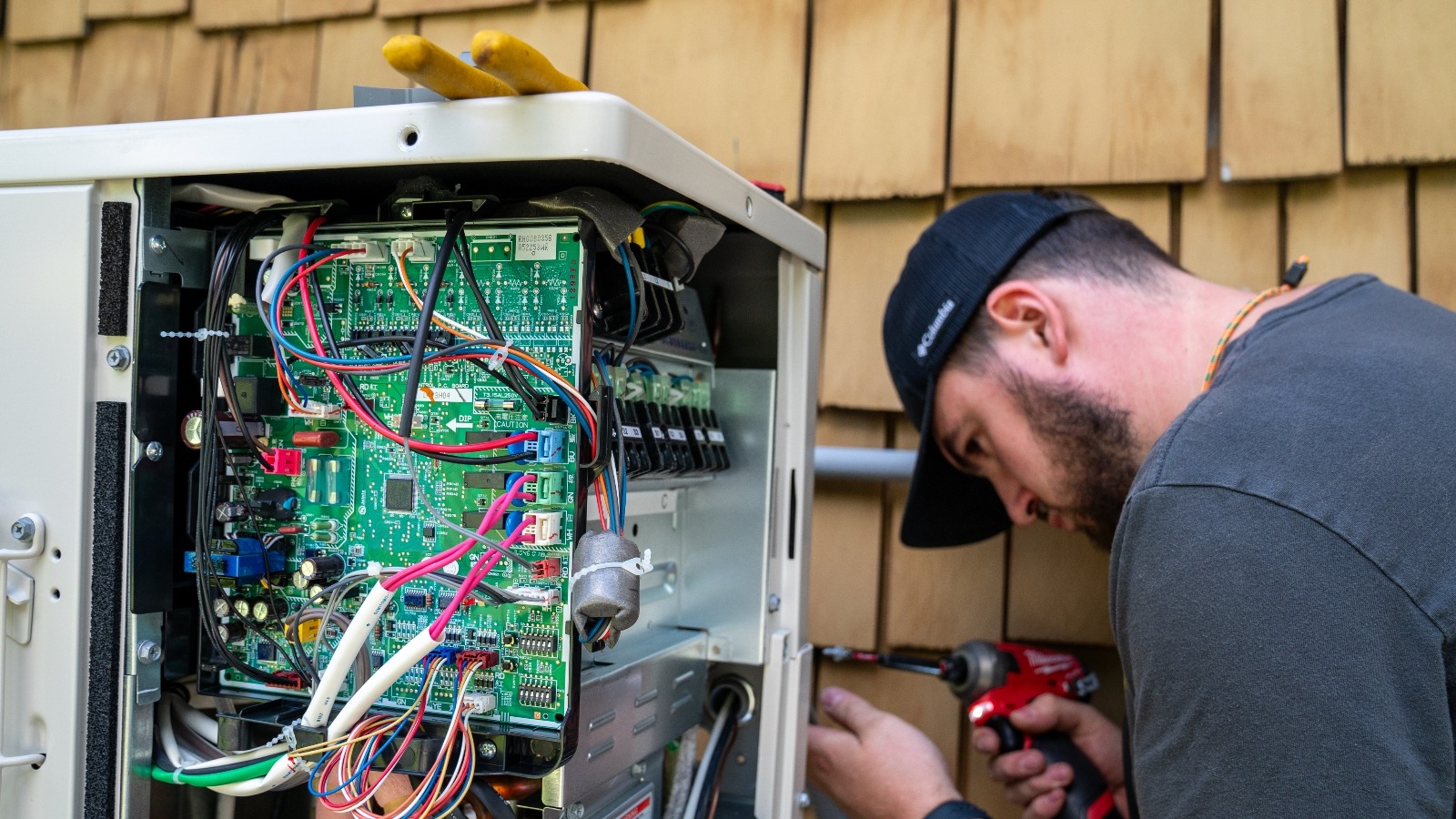Edgemere Farm was born out of a climate catastrophe and community resilience. In the wake of Hurricane Sandy, volunteers transformed an abandoned, flood-damaged, city-owned plot into a lush organic garden.
One day in mid-September, the half-acre site in Far Rockaway, New York, underwent another makeover: For an hour, it became a chai shop. Two hundred people gathered to watch a performance of Flood Sensor Aunty, an hour-long play written by local urban planner and theater artist Sabina Sethi Unni. She stars as an humanized flood sensor — a tool that detects high water levels and delivers that data to a publicly-accessible map.
Sethi Unni’s anthropomorphized device clashes with her chai-shop coworkers and dreams of becoming a movie star. A pair of lovelorn city health inspectors, an attention-seeking city council member, and a rain god running a cult out of a cramped one-bedroom apartment round out the cast.
Many people associate urban flooding with cities like New Orleans and Miami. But it’s becoming more frequent further north, too. Thirty-four of the 43 people killed when Hurricane Sandy pummeled New York City in 2012 drowned in storm-surge flooding, many of them in low-lying neighborhoods. The rain that followed Hurricane Ida’s march up the coast in 2021 killed 13 people, 11 of them in basement apartments. Even a heavy downpour like the one New York experienced in July can inundate homes and threaten lives.
Flood Sensor Aunty strives to educate people about the threat by combining absurdist comedy with practical advice for surviving disasters yet to come. It celebrates the power of the community to overcome crises, while providing audiences with useful, tangible tools like free flood alarms and headlamps provided in collaboration with the city’s Office of Emergency Management and local nonprofits. The play explains how to access 311 and make a disaster plan — through a synth-heavy, brightly-costumed, Chappell-Roan-referencing extravaganza performed in parks, warehouses, and, on at least one occasion, a boat.
Sethi Unni talked about her work at Climate Week in September and recently performed her play in Boston. She hopes to take on other dramatic topics, like community board meetings — and wants to see more artists tackling the climate crisis with humor and hope.
Grist caught up with Sethi Unni to discuss public art as disaster preparedness infrastructure, Facebook pages and gossipy families as artistic inspiration, and just what a flood sensor is, anyway.
This conversation has been edited for length and clarity.
Q: How did you start making climate change theater?
A: Hurricane Ida was a real revelation in terms of the gaps we have in reaching South Asian and Indo-Caribbean communities. People live in basement apartments, which are largely illegal, so people are afraid to reach out to the city. They can’t access tenant protections. They’re just trapped in this net.
People talk about flooding as something that happens when you’re on the coast. But a lot of the neighborhoods most impacted by Ida were inland neighborhoods in Queens with high groundwater tables. In the communities we perform in, like South Queens, flooding is so real, and basement-apartment deaths are real. And the city historically, even though they’re really trying to take all these creative approaches, hasn’t done a great job reaching communities that don’t speak English, communities of color, communities that don’t place faith and trust in the government.
I was in planning school during Hurricane Ida. A lot of my classes were all about how we can floodproof the city. The responses were very top-down — like, “We have to build a sea wall.” Sometimes that’s the right call, but sometimes more soft care infrastructure is what we need. What if more people knew what flooding is? What if we change our politics around basement apartments? I was looking at this as a way to reach communities where they’re at, with trusted messengers [and] cultural references.
In the American consciousness, disasters, specifically flooding and hurricanes, are seen as apolitical. But obviously, where people live in cities is caused by redlining and segregation. In New York, public housing is often in low-lying areas. And a lot of Asian American and Pacific Islander immigrants live in these basement apartments.
Q: What inspired this play — and what, exactly, is a flood sensor?
A: I’m part of this Facebook page called Community Flood Watch. It’s mostly one guy from Howard Beach posting NOAA reports about flooding in Howard Beach. I’m obsessed with floods. Normally, people report flooding through 311 calls. But you have to know what 311 is, you more or less have to speak English, and you have to have the time to call. So [flood sensors] are a good alternative. They produce an alternate form of data that can, hopefully, be used for advocacy.
A flood sensor is super cute. It’s a device that’s put on high surfaces that calculates the distance between whatever height it’s placed at and the ground. When it rains, the distance between it and the ground changes because of the water level. But flood sensors also kind of look like surveillance cameras. So we’re trying to get the word out about this kind of wonky LIDAR technology.
I also think it’s a really good, physical way to talk about flooding, because flooding is very ephemeral, and a flood sensor is very much a thing that exists in the here and now.
Q: It’s still there between the floods.
A: Exactly. It exists when it rains, it exists when it’s sunny. Inland flooding isn’t something that you talk about a lot unless you’re used to your block flooding. But it’s a very severe issue.
Q: So, what role can art play in educating people about these ephemeral but also dangerous things?
A: I think it’s a healthy part of the ecosystem. I think people respond to art — people respond to humor and entertainment and coolness and joy in their neighborhoods. It’s a way of captivating folks. People need information repeated in different ways, whether that’s through song and dance or jazz hands and sock puppets. Sometimes a one-page pamphlet translated into two languages isn’t the best way for people to receive information, but a song about go-bags played on the synth is.
Courtesy New York City Department of Emergency Management
Q: I was struck by how much of the play is about hyperlocal politics. We see people negotiating bureaucracy in order to make a life, build community, survive — the chai shop owners fight a mid-level bureaucrat who very much wants them shut down. So, I now ask: As we navigate the climate crisis, should we have sympathy for bureaucrats?
A: We should and shouldn’t. The show is partially a suggestion to bureaucrats that we can use creative strategies in informing communities about their risk. It doesn’t just have to be a top down thing, or a boring community-board visit. [Flood Sensor Aunty] is making a little fun of bureaucrats who are sticklers about permits, and can cause a lot of harm by acting like urban-planning cops.
But it is also a love letter to our bureaucrats who are trying to make change and push back against this big, uncaring system. We actually have a bureaucrat, Jill Cornell, whom I reached out to for technical assistance. Jill does community engagement with the City Office of Emergency Management. And now she has a monologue in the show, and she’s singing and dancing, and she’s maybe a better dancer than all of us.
Q: At one point, your character in Flood Sensor Aunty says “gossip saves lives.” Is that true?
A: Gossip totally saves lives. Aunty gossip saves lives. In a real sense, folks who are doing the domestic work in households are doing a lot of disaster work. This awesome civil engineer named Sangamithra Iyer, who gave a talkback at one of our performances last spring, spoke about how care work is infrastructure, and the work of women in households is climate infrastructure. Gossip can mean knowing what neighbors I’m supposed to be checking on — this neighbor always takes a walk at this time of day, and I haven’t seen them; these neighbors are elderly, I should probably call them. That kind of gossipy, busybody work is how we save lives.
I talk about my real neighbors in the show. We share mint from our gardens, feed the same stray cats, check in on each other after storms.
Q: Trying to get attention in a busy public park is difficult. How do you get your message across despite all the noise and distraction that being in public in a big city implies?
A: It’s usually just being the boldest and brightest thing. When we were creating our set, we were like, “What color contrasts best against green and blue?” But we want to let the place shine through — like, if we’re in Edgemere, we’re in Edgemere. The beautiful tomato stalks are part of the set, too.
There’s this genre within public art called “useful art.” Even if you don’t really listen to what we’re saying, we’re giving you a go-bag, we’re giving you a flood alarm, we’re giving you a headlamp, we’re giving you all these resources to keep yourself safe. A lot of people think plays are really good opportunities to change hearts and minds, but sometimes people just need to know what’s going on. Maybe they should think about the racial politics of social risk, but maybe they also just need a flood alarm for their basement, too.
There’s a mainstream climate policy belief that we protect ourselves against flooding through Army Corps of Engineers projects, like a sea wall. But what if, also, the things that keep us safe are knowing our neighbors, loving our aunties, checking in on elderly people in our communities? These soft forms of infrastructure also deserve funding and attention, and should be seen as real forms of infrastructure, too.
Source link
Sophie Hurwitz grist.org


